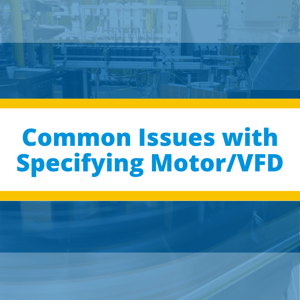 There are numerous efficiency and regulatory standards that design engineers must follow without asking any questions. Efficient and reliable systems are necessary for maximum productivity. In order to guarantee this, engineers must make sure all common motor/VFD specifications issues have been resolved.
There are numerous efficiency and regulatory standards that design engineers must follow without asking any questions. Efficient and reliable systems are necessary for maximum productivity. In order to guarantee this, engineers must make sure all common motor/VFD specifications issues have been resolved.
Service Factor
Typically, motors are rated at 1.15 service factor, but it is a common practice by manufacturers to reduce the service factor to 1.0 when integrating a VFD. Doing so is a positive step, as it kills any overload risks that the motor may undergo while also improving the longevity of the equipment.
High Altitude
The service factor of motors can take a toll when motors are operated in hilly locations, such as 3300 ft. above sea level. The main reason behind this is reduced cooling air. Therefore, it is recommended that the service factor be seen as 1.0 rather than 1.15.
Speed Range
General-duty induction motors in the market are typically rated to work at 10:1 turndown ration without overheating the winding insulation excessively. On the other hand, basic inverter duty rated motors can operate at 20:1 ratio when combined with scalar (V/Hz) VFD. The range of speed at which the induction motor should operate depends on the load. If you require a super-high turndown ration, such as 1000:1, along with high level of low-speed torque, then you should opt for a VFD with vector control.
Closed-loop vector control
Closed-loop vector control should be utilized only if you are absolutely sure that it is needed. The control technique does bring in additional precision compared to open-loop but requires the addition of a hall effect sensor or optical shaft encoder to detect the rotation. This can add an extra $1000 on top of the existing equipment, thus, the statement in the beginning.
Peak induction motor efficiency
Induction motors achieve peak efficiency when they are operated at around 75% of full-load. Deviating too much from this range can adversely affect the efficiency, but below 20% loading, the performance follows an exponential downward trend due to inconsistent air gap magnetic flux. If the design requirements involve operation of load below this level, then it is advisable to make use of multiple smaller motors. Even though the initial cost would be higher, the benefits would be reaped in the long-run.
High VFD carrier frequencies
High VFD carrier frequencies are surely beneficial as they provide improved PWM output waveform resolution/shaping, that allows better dynamic response and low-speed torque control. However, these frequencies also build up the “reflected wave” phenomenon that increases losses and reduces lifetime. A study found that increasing the frequency from 3 to 12 kHz would reduce the insulation life from 100,000 to 25,000 hours.
VFDs for over-speeding
Drives are not only useful when it comes to slowing down motors but are also handy when performance above the rated speed is required. This can be done by increasing the VFD output frequency above 50/60Hz (line frequency). The practice is followed by some HVAC equipment for fan and motor combinations, even though the approach isn’t fully endorsed. Nonetheless, several motor manufacturers allow such tweaking up to a certain point, therefore it is necessary to consult the documentation before proceeding. A design engineer’s services can also be utilized to evaluate the load profile and the period of time at which over-speeding needs to be carried out. Doing so would allow maintenance activities to be scheduled at the right time, lowering the risk of a complete breakdown.
Interested in learning more? Visit our website www.premierautomation.com, or talk to one of our specialists today.



-1.png)
